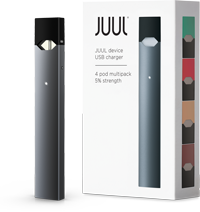Since their invention, vaporized cigarettes, or e-cigs, as they're commonly referred to, have failed to take off as expected. E-cigs, in short, are devices that deliver nicotine or other chemicals from flavored vapors. Able to deliver nicotine without the harsh smell of cigarettes, and a conceived notion of less harmful effects than cigarettes, many expected the devices to be the future of smoking. When one views the high prices, inaccessibility, and ugly devices, as well as the decreasing popularity of smoking as a whole, however, it's easy to see why this trend hasn't quite caught on. Nonetheless, over the past year, one vaping company has been able to defy this trend. Invented in 2015 by PAX Labs, the JUUL was spun off as a separate company when it began to take off early last year. In contrast to many of the devices before it, the JUUL is sleek in design, relatively inexpensive, and supposedly provides a higher quality experience than any other device. These factors, combined with a vast array of fun flavors, and clever marketing have made JUULs a hit (haha).
 |
JUUL Starter Pack
|
On their
website, JUUL claims to have the sole purpose of helping existing smokers quit, and claims to have converted around 500,000 previous smokers. Its effectiveness as a quitting aid will be analyzed later in this post, but there is a much more troubling population using JUULs:
teenagers. Lured in by the cool design and fun flavors, teens across the country are going crazy over JUULs. At Montclair High School, even, usage became so prevalent that the Superintendent had to enact protocol and issue warnings to reduce JUULing in school. MHS bathrooms are constantly patrolled by security now, and certain bathrooms are locked at all times. Due to inexplicable FDA delays, JUUL has not had to fully disclose their ingredient list. However, it is known that JUULS contain around 0.7mL of Nicotine per pod. JUUL claims that this is roughly equal to the amount of Nicotine in a pack of cigarettes, but fail to mention that the pack of cigarettes they are comparing to possess the highest nicotine content on the market. To this point, a significant portion of the nicotine in this alleged pack of cigarettes would not be ingested, as cigarette smokers rarely smoke the entirety of a cigarette, and Nicotine emission occurs between puffs. In JUULS, however, no Nicotine is lost between inhalations, and JUUL pods are almost always finished in their entirety. As I will explain below, this is causing immense damage to the brains of teenagers across the country.
The Effect of Nicotine
In the brain, neurons transmit nerve impulses in order to signal for the body to react to any given stimuli. For example, in order to type this blog post, neurons are passing on chemical signals leading to the contraction of the muscles that cause my fingers to move. When the impulse reaches the end of each neuron, neurotransmitters are released into the synapse (the area between neurons and neurons and muscle cells), and then bind to receptors on the next neuron or muscle cell to continue the response onward. Here's where we encounter our problem with JUULs. When someone takes a hit from a JUUL, loads of nicotine enter the bloodstream and are carried to the brain. Unfortunately, nicotine is very similar in shape to acetylcholine, a common neurotransmitter. This means that nicotine can also bind to the acetylcholine receptors on other neurons. As one would expect, this leads to an excess of chemical signals in the synapses. The brain recognizes the surplus of signaling molecules, and in response, reduces both the amount of acetylcholine it releases and the number of acetylcholine receptors. Once this occurs, the brain can no longer maintain normal neuron function without the presence of nicotine, as there is now an insufficient amount of acetylcholine being released. This is why nicotine addicts experience decreased energy and focus, and is also why nicotine is so addictive. A JUUL user now craves nicotine just to maintain normal brain function. Over time, the amount of acetylcholine and receptors will gradually build back up, but only if nicotine is not used. This is why JUULing makes no sense as a smoking alternative. JUULing sends the same, if not more, nicotine into the body than cigarettes, maintaining the reduced levels of acetylcholine and keeps users hooked.
Additionally, nicotine can stimulate the release of dopamine. Dopamine is a hormone that aids in the regulation of pleasure centers in our brain. As a result, repeated JUULing can condition individuals to associate the device with feelings of pleasure and cause further addiction. As the brains of teenagers are still developing, it is easy to see how these effects can drastically impact the brain longterm.
So, unless you want some serious longterm effects to your brain, and bank account, don't JUUL. Besides, why whack a JUUL when you can just eat a
Tide Pod instead!

No comments:
Post a Comment